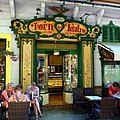Conjunt històric de Palma
cultural property in Palma de Mallorca, Spain | |||||
| Upload media | |||||
| Instance of | |||||
|---|---|---|---|---|---|
| Location | Palma, Mallorca, Balearic Islands, Spain | ||||
| Heritage designation |
| ||||
 | |||||
| |||||
This is a photo of a historical area listed in the Spanish heritage register of Bienes de Interés Cultural under the reference RI-53-0000046. |
| The historic center of Palma was declared Historic-Artistic Grouping in 1964, and is classified as a Bé d'Interès Cultural (Property of Cultural Interest), protection that affects the entire city within the old walled perimeter. It is an urban complex of Roman origins, with a mainly Islamic street layout, dominated by Gothic and Baroque constructions with important interventions in the 19th and 20th centuries. |
Seafront
[edit]One of the highlights of the historic center is the view of the seafront, with the Almudaina Royal Palace, the Cathedral and the Episcopal Palace (left to right) above the wall reflected on the water.
-
Almudaina Royal Palace
-
At night
-
The Cathedral
-
The Cathedral at night
-
1893
-
1920
Religious buildings
[edit]Gothic churches
[edit]Mallorca was conquered in the 13th century and the kings of the House of Barcelona undertook a monumentalization project that resulted a large number of Gothic churches.
-
Portal del Mirador of the Cathedral
-
Interior of the Cathedral
-
Absis of Sant Francesc
-
Façade of Sant Francesc
-
Lateral portal of Santa Eulàlia
-
Façade of Santa Eulàlia (Gothic revival)
-
Façade of Sant Miquel
-
Church bell of Santa Creu
-
Façade of Sant Nicolau
-
Absis of Santa Margalida
-
The small church of Santa Fe
-
The chapel of Sant Feliu
Baroque churches
[edit]-
Main portal of Montision church, the most important baroque church
-
Detail of the main portal of Montision
-
Cloister of Sant Antoniet
-
Detail of the main portal of the church of Sant Francesc
-
Main portal of Sant Jeroni
-
Façade of El Socors church
Monasteries
[edit]-
Courtyard of the monastery of Santa Clara
-
Monastery of Sant Jeroni
-
Monastery of Santa Magdalena
-
Monastery of Santa Teresa
-
Church of the monastery of Santa Teresa
-
Church of the former monastery of Santa Catalina de Sena
Institutional and civil buildings
[edit]-
City Hall (17th century)
-
La Llonja (15th century)
-
Interior of la Llonja
-
Consolat de Mar (17th century)
-
Consell Insular (19th century)
-
Teatre Principal (19th century)
Minor palaces
[edit]-
Can Solleric (18th century)
-
Can Catlar (16th century)
-
Ca la Gran Cristiana
-
Episcopal Palace
-
Can Berga (18th century)
-
Les Carasses (16th century)
-
Can Bordils (16th century)
-
Can Formiguera (17th century)
-
Cal Marquès de la Torre
-
Can Olesa (16th century)
-
Can Chacón (18th century)
-
Can Cirera (16th century)
Cortyards
[edit]Courtyards are a very typical and singular element of manor houses in Mallorca, which are organized around it. The entrance door leads to a large courtyard, which is often the most monumental part and until 20th century it functioned as a semi-public space.
-
Cal Comte de la Cova (Gothic)
-
Can Catlar del Llorer (Gothic)
-
Can Bordils (16th century)
-
Can Fortesa del Sitjar (17th century)
-
Can Morell de les Caputxines (17th century)
-
Can Olesa (17th century)
-
Can Montenegro (17th century)
-
Can Vivot (18th century)
-
Can Berga (18th century)
-
Can Armengol (19th century)
-
Can San Simon (19th century)
-
Can Espanya (19th century)
Defensive architecture
[edit]-
Almudaina Royal Palace
-
Bastió de Sant Pere
-
Bastió del Príncep
-
Promenade over the city walls
-
La Portella city gate
-
El Temple towers
Streets and alleys
[edit]-
Costa de la Seu
-
Plaça d'en Coll
-
Carrer de l'Almudaina
-
Carrer de la Posada de la Real
-
Passeig del Born
-
Carrer del Forn de l'Olivera
-
Carrer de Sant Francesc
-
Carrer de Santa Eulàlia
-
Carrer de Can Savellà
-
Plaça de Sant Jeroni
-
Costa de Can Santacília
-
Carrer Estret de Sant Jaume
-
Carrer de Can Serra
-
Carrer del Vi
-
Carrer de Catany
-
Placeta del Call
-
Carrer de Can Cifre
-
Born de Santa Clara
Art Nouveau Architecture
[edit]In Palma, Art Nouveau develops from the model of Barcelona modernisme, with local architects.
-
Gran Hotel (Domènec i Muntaner)
-
Can Casasayas and the Pensió Menorquina (Francesc Roca Simó and Guillem Reynés)
-
Can Corbella (Nicolau Lliteres)
-
Can Forteza Rey (Lluís Forteza-Rey)
-
Magatzems l'Àguila (Gaspar Bennàssar)
-
Forn del Teatre (anonymous)

































































































